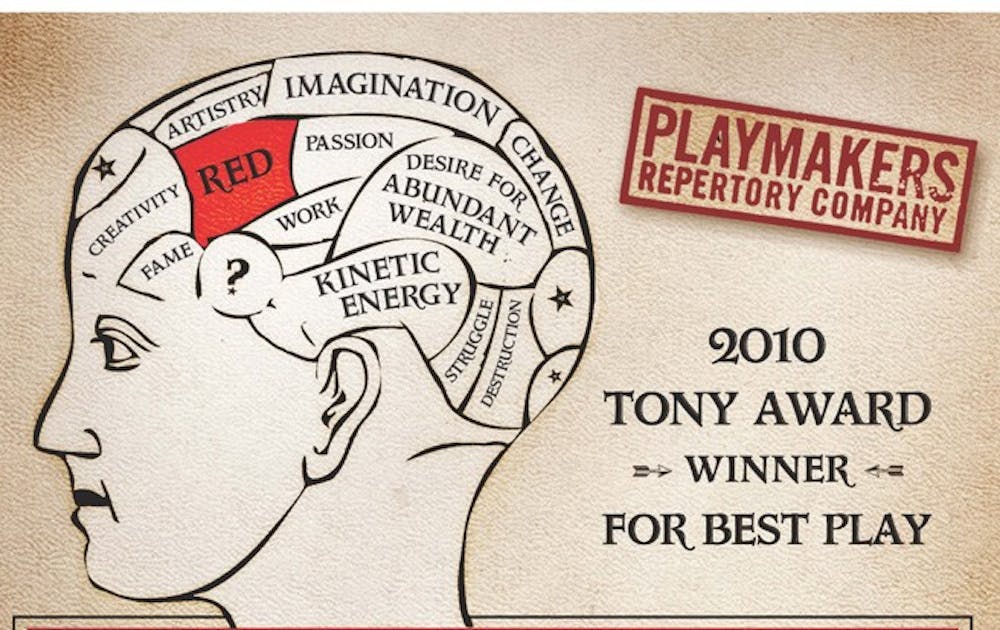When the 1950s replica pendant lights darken on the abstract painter Mark Rothko, portrayed with virile and unnerving authority by Stephen Caffrey, there’s a real fear that Rothko’s nightmare will be realized, that “one day the black will swallow the red.” Such is the power with which Caffrey, and his counterpart Matt Gardner (as Rothko’s employee Ken), vivify John Logan’s Tony-award winning one-act, Red. Produced by PlayMakers’ Repertory Theater at UNC-Chapel Hill, the drama synchronizes all levels of theatrical technique to tease the passion out of Logan’s highly intellectual dialogue on artistic expression.
The play imagines the interaction between Mark Rothko and his workshop assistant, Ken, as they spend an hour battling over the role of contemplation and honesty in art. Of course, there’s a risk of getting lost in references to Nietzsche’s The Birth of Tragedy (Rothko’s self-cited muse) and the works of the artist’s various contemporaries. To overcome the heady nature of Red’s discourse, then, is no trifling feat. Yet the text, which imagines the Russian-immigrant Rothko just before his 1959 mural commission for the Four Seasons restaurant, never feels too talky under director Vivienne Benesch’s patient and sensitive blocking.
With such a legendary personality as Rothko represented onstage, it’s hard not to be intimidated by the desire for historical accuracy. Yet scenic designer Jan Chambers took on the challenge of reproducing Rothko’s private atelier with confidence. She accurately dresses the Paul Green Theatre with an elegant frosted-window warehouse backdrop, a careful selection of period-sensitive furniture and workshop apertures and a tasteful spattering of stray paint across sepia-tone hardwood flooring.
The technical merits go on. In a play primarily about color and the feelings produced thereby, proper stage illumination couldn’t be more crucial. Designer Charlie Morrison tackles the need for subtle yet symbolic lighting by attacking the space from every angle. Rows of precision spotlights accentuate key destinations for actor crosses, and a fully wired workshop allows Rothko and Ken to tamper with brightness mid-scene. The glow from below, a fringe of soft color lining the underside of the thrust stage, heightens the mood as the hue shifts with beats.
If it appears that PlayMakers’ Red is disproportionately about technical finesse, then I need to make clear how effectively Caffrey and Gardner transformed their props from otherwise functional crutches into integral tools for the cultivation of emotion. The absence of any stagehands between scenes—Caffrey and Gardner keep in character while Rothko broods on his canvas and Ken reworks the space—make transitions through time appear seamless. Even without the aid of their technical team, Rothko and Ken are ideal complements. Caffrey nails Rothko’s biting cynicism for the mainstream with a grit and rasp that only endears his artistic ideals further to the audience. Gardner no doubt channeled the youthful enthusiasm of the surrounding Tar Heels into his performance; Ken’s equally convincing characterization makes it hard to pick a side in the intellectual art-clash. As an actor anxious to keep my own creative process honest, I found Gardner’s performance especially brought me to tears, proving that discourse about art can be both cerebral and moving.
Now, don’t panic if you don’t know how the grand Athenian tragedy plays into 20th century expressionism, or even if the word “Dionysian” conjures nothing more than a blank stare. PlayMakers’ Red exudes a “blood-soaked-Ferrari-sunrise” passion that is well worth the Robertson bus.
PlayMakers presents Red at the Paul Green Theatre in Chapel Hill through October 7.
Get The Chronicle straight to your inbox
Signup for our weekly newsletter. Cancel at any time.

